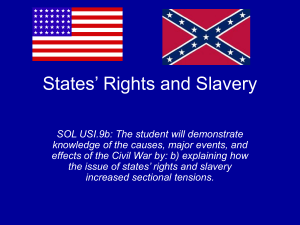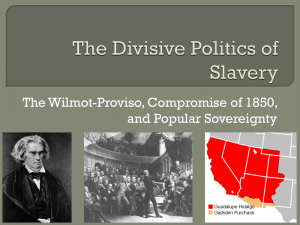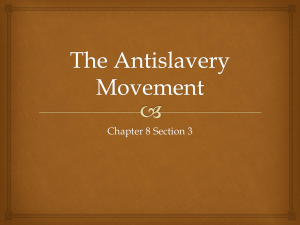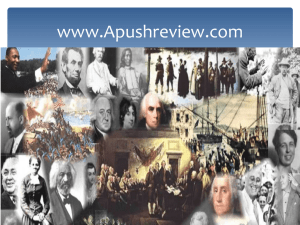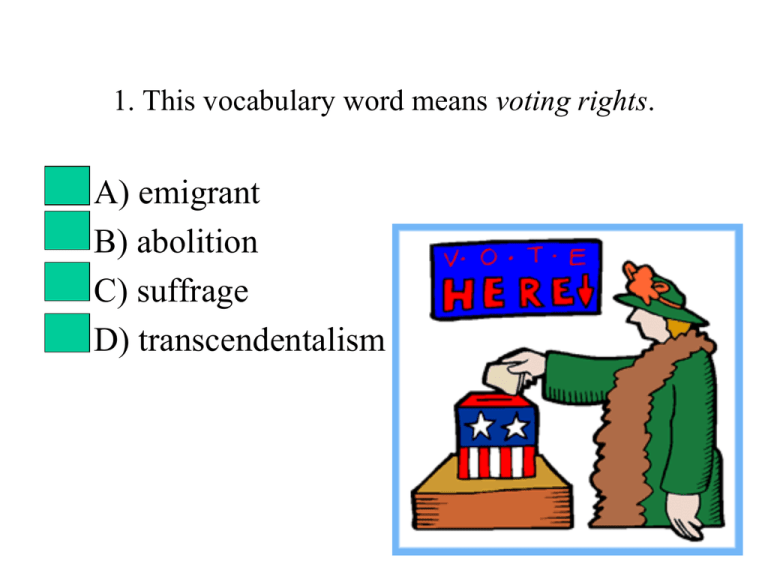
1. This vocabulary word means voting rights.
•
•
•
•
A) emigrant
B) abolition
C) suffrage
D) transcendentalism
Correct !!
Next
Question
2. The movement to end slavery was called
__________.
•
•
•
•
A) suffrage
B) popular sovereignty
C) transcendentalism
D) abolition
Correct !!
Next
Question
3. What person escaped from slavery, became a wellrespected speaker, traveled overseas, and published an
antislavery newspaper?
•
•
•
•
A) Lloyd Garrison
B) Frederick Douglass
C) John Brown
D) Harriet Tubman
Correct !!
Next
Question
4. Why did white Southerners NOT want slaves to
learn to read?
•
•
•
•
A) No colleges accepted African Americans.
B) They feared that educated slaves would rebel.
C) Reading was not a skill slaves would use.
D) There was a shortage of available books.
Correct !!
Next
Question
5. For what reason is Harriet Tubman famous?
•
•
•
•
A) She gave a speech at Seneca Falls.
B) She helped people with mental illness.
C) She was a conductor on the Underground Railroad.
D) She wrote abolitionist poetry.
Correct !!
Next
Question
6. This is associated with expanded rights for women including
the right to vote.
•
•
•
•
A) Sack of Lawrence
B) Kansas-Nebraska Act
C) Dred Scott case
D) Seneca Falls Convention
Correct !!
Next
Question
7. She was an antislavery reformer who also
worked for women’s rights.
•
•
•
•
A) Sojourner Truth
B) Mrs. Frederick Douglass
C) Elizabeth Cady Stanton
D) Harriet Tubman
Correct !!
Next
Question
8. Why did Stanton and Mott organize the
Seneca Falls Convention?
•
•
•
•
A) because male abolitionists were slow to organize a movement
B) to win for women the same rights as men
C) to form an all-female antislavery organization
D) to win women’s support for more public schools
Correct !!
Next
Question
9. What did the women’s rights movement and the
abolitionist movement have in common?
•
•
•
•
A) both began in Seneca Falls
B) women made up the largest number of supporters
C) temperance workers supported both movements
D) both tried to help a group that had been denied their rights by law
Correct !!
Next
Question
10. The Kansas-Nebraska Act called for
_____.
•
•
•
•
A) the residents of Kansas & Nebraska vote to decide the issue of slavery
B) the punishment of slaveholders in Kansas for attacks on antislavery settlers
C) a ban on slavery in Kansas and Nebraska
D) land in Kansas and Nebraska to be given to escaped slaves
Correct !!
Next
Question
11. What was the impact of Uncle Tom’s Cabin?
•
•
•
•
A) It caused the proslavery settlers to attack antislavery settlers in Kansas.
B) It convinced Northerners to support the Fugitive Slave Act.
C) White Southerners charged that the book did not portray slavery accurately.
D) It angered Northerners because it described slavery as a positive experience.
Correct !!
Next
Question
12. Who wrote Uncle Tom’s Cabin?
•
•
•
•
A) William Lloyd Garrison
B) Harriet Beecher Stowe
C) Sojourner Truth
D) Elizabeth Cady Stanton
Correct !!
Next
Question
13. Stephen A. Douglas tried to win Southern support for
the Kansas-Nebraska Act by allowing the issue of
slavery in these territories to be settled by ______.
•
•
•
•
A) the establishment of the Free Soil Party
B) representative government
C) popular sovereignty
D) primary elections
Correct !!
Next
Question
14. How were educational opportunities limited
for African Americans in the 1800’s?
•
•
•
•
A) Horace Mann set up schools for them because he believed in the power of education.
B) They had to go to special schools also attended by women.
C) African Americans had to secretly set up their own schools.
D) It was illegal in the South to teach an enslaved person to read.
Correct !!
Next
Question
15. What role did John Brown play in the slavery
controversy?
•
•
•
•
A) He attacked an antislavery senator in the Senate.
B) He murdered several proslavery settlers in Kansas.
C) He fought for the passage of the Fugitive Slave Act.
D) He introduced the Kansas-Nebraska Act in Congress.
Correct !!
Next
Question
16. What bill unsuccessfully attempted to ban
slavery in any territory gained from the War with
Mexico?
•
•
•
•
A) Missouri Compromise
B) Wilmot Proviso
C) Compromise of 1850
D) Dred Scott Decision
Correct !!
Next
Question
17. What bill settled the controversy over
slavery in California and the rest of the Mexican
Cession?
•
•
•
•
A) Missouri Compromise
B) Dred Scott Decision
C) Compromise of 1850
D) Wilmot Proviso
Correct !!
Next
Question
18. Which political party was dedicated to stopping the expansion
of slavery?
•
•
•
•
A) Federalists
B) Whigs
C) Democratic
D) Free-Soil Party
Correct !!
Next
Question
19. Which law aroused great opposition and
widespread disobedience in the North?
•
•
•
•
A) the Emancipation Proclamation
B) the Missouri Compromise
C) the Fugitive Slave Act
D) the Wilmot Proviso
Correct !!
Next
Question
20. Whose lawsuit to gain freedom was denied in a
landmark Supreme Court decision?
•
•
•
•
A) Harriet Beecher Stow
B) Dred Scott
C) Charles Sumner
D) Stephen A. Douglas
Correct !!
Next
Question
21. How did the outbreak of the War
with Mexico revive disagreements over
slavery?
•
•
•
•
A) The South sent slaves to fight in the War with Mexico.
B) Northerners tried to block the admission of California as a slave state.
C) Some congressmen wanted to force Mexico to abolish slavery.
D) Northerners believed Southerners wanted to expand slavery into new lands.
Correct !!
Next
Question
22. Northerners were unhappy about the
fate of which two people?
•
•
•
•
A) Dred Scott and John Brown
B) Abraham Lincoln and Charles Sumner
C) Stephen A. Douglas and Abraham Lincoln
D) John Brown and Preston Brooks
Correct !!
Next
Question
23. Which of the following was favored by white
Southerners but opposed by Northerners?
•
•
•
•
A) the Compromise of 1850
B) the Wilmot Proviso
C) the Fugitive Slave Act
D) the Crittenden Plan
Correct !!
Next
Question
24. Why did John Brown lead an attack on Harpers
Ferry?
•
•
•
•
A) to get revenge for his brother’s death
B) to gain weapons to fight the Civil War
C) to inspire slaves to fight for freedom
D) to punish those who enforced the Fugitive Slave Act
Correct !!
Next
Question
25. Which of the following made white
Southerners fear that the North would abolish
slavery?
•
•
•
•
A) Harriet Beecher Stowe’s book won the Nobel Peace Prize.
B) The President ordered the army to free Mexican slaves.
C) Northern abolitionists helped slaves in Mexico to escape.
D) Northerners in Congress tried to pass the Wilmot Proviso.
Correct !!
Next
Question
26. What impact did Uncle Tom’s Cabin have on the
slavery controversy?
•
•
•
•
A) It gave a true account of slavery.
B) White Southerners viewed it as an unfair attack on their lifestyle.
C) It led to the Fugitive Slave Act being repealed.
D) The profits from the sale of the books supported runaways.
Correct !!
Next
Question
27. This political party was dedicated to stopping
the spreading of slavery.
•
•
•
•
A) Whigs
B) Free-Soil Party
C) Libertarian
D) Jacksonian Democracy
Correct !!
Next
Question
28. This man was responsible for getting Congress to
accept the Compromise of 1850.
•
•
•
•
A) David Wilmot
B) Dred Scott
C) Stephen A. Douglas
D) Frederick Douglass
Correct !!
Next
Question
29. What effect did the Compromise of 1850 have on slavery?
•
•
•
•
A) Congress admitted California as a free state.
B) Congress passed a stronger law to recapture fugitive slaves.
C) Congress banned the slave trade in Washington, D.C.
D) All are true.
Correct !!
Next
Question
30. This settled the controversy over statehood for
California and the issue of slavery in territories
gotten from Mexico.
•
•
•
•
A) Emancipation Proclamation
B) Wilmot Proviso
C) Compromise of 1850
D) Missouri Compromise
Correct !!
Next
Question
•
•
•
•
31. This Northerner supported the
Compromise of 1850 in order to keep the
nation from breaking apart.
A) Henry David Thoreau
B) Daniel Webster
C) Edgar Allan Poe
D) Harry Beecher Stowe
Correct !!
Next
Question
32. This man created a plan to settle the issue of
statehood for California that satisfied both
Northerners and Southerners.
•
•
•
•
A) James Fenimore Cooper
B) Dred Scott
C) William Lloyd Garrison
D) Henry Clay
Correct !!
Next
Question
33. What could happen to Northerners
who refused to obey the Fugitive Slave
Act?
•
•
•
•
A) receive a fine and possibly a jail sentence
B) their property could be seized
C) they got several warnings before a punishment was given
D) breaking this law was punishable by death
Correct !!
Next
Question
34. What was a common symbol used by slaves to
guide them to the North?
•
•
•
•
A) the planet Venus
B) a full moon
C) the North Star
D) a setting sun
Correct !!
Next
Question
35. These were used to signal and direct
slaves to escape routes.
•
•
•
•
A) fires
B) quilts
C) maps with detailed written directions
D) bread crumbs
Correct !!
Next
Question
36. Henry Brown shipped himself in a ________.
•
•
•
•
A) reinforced sack
B) mailing pouch
C) box
D) barrel
Correct !!
Next
Question
Congratulations, you are done!
Click here to reset
quiz
Sorry, try again.
Return
to
Question


